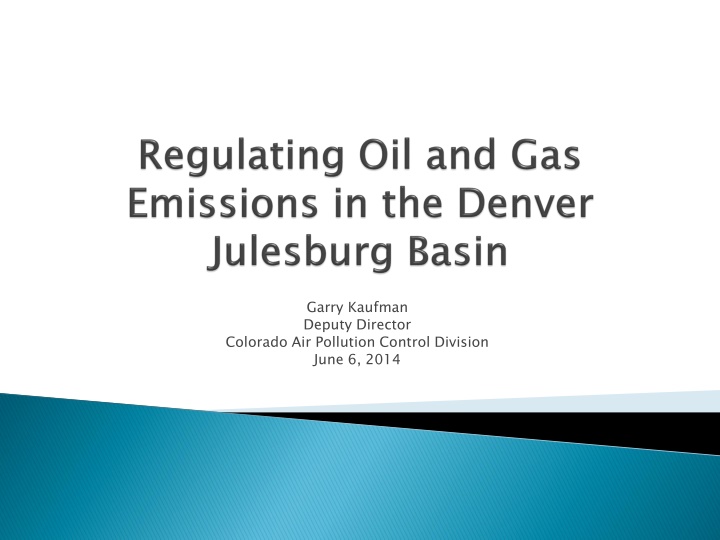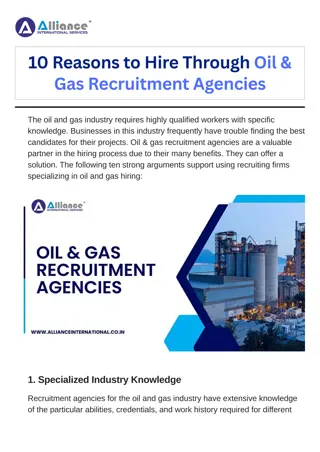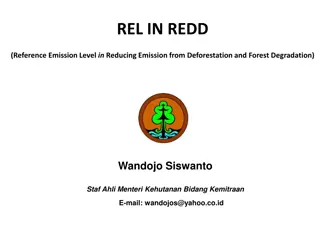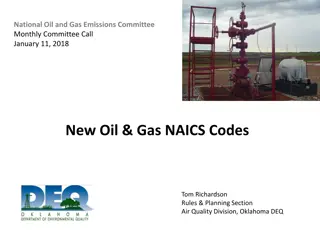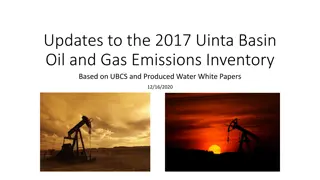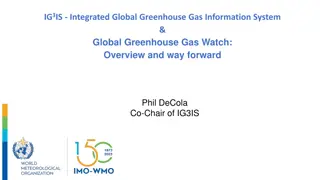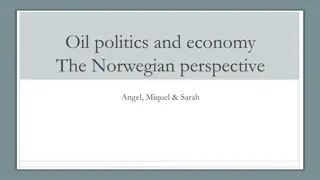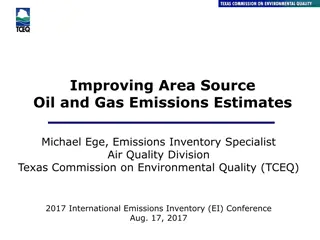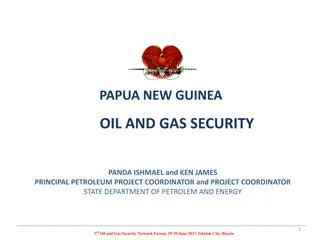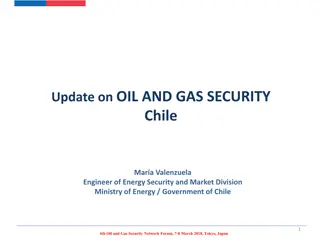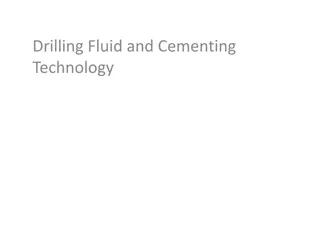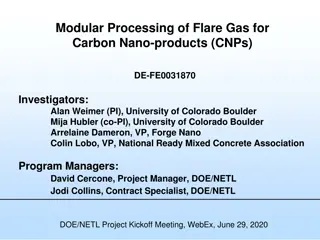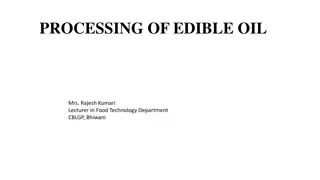Strategies for Oil and Gas Emission Reduction in Colorado
Garry Kaufman, Deputy Director of the Colorado Air Pollution Control Division, outlines efforts to reduce air pollution from oil and gas emissions, focusing on past initiatives, ozone standards, and methane reduction strategies. The historical context sheds light on the evolution of regulations and monitoring practices, highlighting the importance of addressing VOC emissions. Recent data on ozone levels and regulatory measures underscore the ongoing commitment to improving air quality and combatting climate change through targeted policies and industry regulations.
Download Presentation

Please find below an Image/Link to download the presentation.
The content on the website is provided AS IS for your information and personal use only. It may not be sold, licensed, or shared on other websites without obtaining consent from the author.If you encounter any issues during the download, it is possible that the publisher has removed the file from their server.
You are allowed to download the files provided on this website for personal or commercial use, subject to the condition that they are used lawfully. All files are the property of their respective owners.
The content on the website is provided AS IS for your information and personal use only. It may not be sold, licensed, or shared on other websites without obtaining consent from the author.
E N D
Presentation Transcript
Garry Kaufman Deputy Director Colorado Air Pollution Control Division June 6, 2014
Air quality need for oil and gas emission reductions Past efforts 8-Hour Ozone Early Action Compact 8-Hour Ozone Action Plan 2014 Oil and Gas Rulemaking Conclusions
Historically oil and gas emission reduction strategies implemented to address violations of the ozone National Ambient Air Quality Standard in the Denver Metro/North Front Range Area Primarily volatile organic compound (VOC) reduction strategies 2014 rulemaking also considered methane reductions as part of Colorado s efforts to address global climate change
For NAAQS of 0.075 ppm For NAAQS of 0.075 ppm (Draft data for 2013) Three Year Average 4th Maximum Ozone Values *** 2013 data through 30 September *** 2011 8-hr. O3 4th Max. Value (ppm) 2012 8-hr. O3 4th Max. Value (ppm) 2013 8-hr. O3 4th Max. Value (ppm) 2014 Highest Allowable 4th Max. (ppm) East Slope Sites 3-yr. Avg. 4th Max. Value (ppm) Site Name AQS # Welby Highland Aurora East S. Boulder Creek CAMP La Casa Chatfield State Park USAF Academy Manitou Welch Rocky Flats North NREL Aspen Park Fort Collins - West Rist Canyon * Fort Collins - CSU Weld County Tower 08-001-3001 08-005-0002 08-005-0006 08-013-0011 08-031-0002 08-013-0026 08-035-0004 08-041-0013 08-041-0016 08-059-0005 08-059-0006 08-059-0011 08-059-0013 08-069-0011 08-069-0012 08-069-1004 08-123-0009 0.075 0.078 0.077 0.076 --- --- 0.082 0.074 0.075 0.077 0.081 0.083 0.072 0.080 0.073 0.068 0.077 0.077 0.080 0.074 0.076 0.068 --- 0.086 0.075 0.075 0.079 0.084 0.081 0.077 0.080 0.071 0.074 0.080 0.077 0.079 0.073 0.079 0.067 0.071 0.083 0.074 0.072 0.080 0.085 0.084 0.077 0.082 0.066 0.074 0.073 0.073 0.068 0.080 0.072 0.092 --- 0.058 0.078 0.080 0.068 0.058 0.062 0.073 0.065 --- * 0.079 0.074 0.076 0.079 0.074 0.077 --- --- 0.083 0.074 0.074 0.078 0.083 0.082 0.075 0.080 0.070 0.072 0.076 NPS - Rocky Mtn. NP NOAA - BAO Tower NOAA - Niwot Ridge * Rist Canyon site closed 6/28. 08-069-0007 n/a n/a 0.077 0.076 0.067 0.079 0.077 0.076 0.074 0.064 0.070 0.074 0.086 0.081 0.076 0.072 0.071 (NOAA thru 6/23)
Prior to the early 2000s oil and gas sector was considered to be an insignificant contributor to VOC emissions in the Denver Metro/North Front Range Area Until 2003, condensate storage tanks at oil and gas production facilities were exempt from reporting and permitting requirements Little or no understanding of the potential for VOC leakage and venting at oil and gas production facilities
In early 2000s APCD discovered that flashing at condensate storage tanks was a significant source of VOC emissions in DMA/NFR flashing occurs when petroleum liquid that is under high pressure underground is put into an atmospheric tank Previously APCD assumed that emissions from tank were limited to evaporative losses (working and breathing losses) For 2002 estimated flashing emissions in DMA/NFR of 134 tons per day 2004 Early Action Compact emission inventory
To avoid 8-hour Ozone NAAQS non-attainment designation for the DMA/NFR, Colorado entered into Early Action Compact with EPA in 2004 (EAC), which included 1st Colorado regulations for reducing VOC emissions from oil and gas operations Operators in DMA/NFR required to reduce condensate tank emissions by 47.5% on a system-wide basis during ozone season (May 1- September 30) Lesser control level during rest of year Control dehydrators emitting 15 tpy or greater VOC Engine controls Leak detection at existing gas plants
2004 condensate tank emission reduction requirements assumed modest growth in emissions 2002 uncontrolled emissions=134 tpd 2007 projected uncontrolled emissions 146 tpd By 2006 it was clear that growth in tank emissions was significantly underestimated 2006 uncontrolled emissions =211 tpd To address growth Air Quality Control Commission increased tank control percentage 75% control during ozone season starting in 2007 78% control during ozone season starting in 2012
All tanks required to be controlled during 1st 90 days of production Production/emissions highest during this period and declines thereafter Prior to 2006, tanks were not being controlled during this initial period to allow operators to determine expected production/emissions Additional monitoring, recordkeeping and reporting requirements to enhance compliance New state-wide rules to proactively address oil and gas emissions outside the DMA/NFR
DMA/NFR 8-Hour Ozone non-attainment designation in 2007 Extensive inventory analysis and photochemical modeling to identify controls and demonstrate projected compliance with standard by 2010 Additional oil and gas emission reduction strategies Increase tank control percentage (81% in 2009, 90% in 2011) Low-bleed pneumatic requirement (projected 23 tpd emission reduction)
New rules target VOC and methane emissions from the oil and gas production sector 1st in the nation rules to specifically require methane emission reductions from O&G New rules expected to reduce VOC emissions by approximately 94,000 tpy, methane emissions by approximately 64,000-113,000 tpy, at an overall annual cost of approximately $ 42 million New rules establish emission reduction requirements for the largest O&G source categories Tanks Fugitives/Venting Pneumatic devices
Expand control requirements for storage tanks Lower statewide control threshold from 20 tons per year to 6 tons per year Include crude oil and produced water storage tanks Require controls during the first 90 days of production statewide Improve capture of emissions at controlled tanks Controlled tanks must be operated without venting to the atmosphere Establish requirements for Storage Tank Emission Management systems (STEM) Capture performance evaluation Certified design to minimize emissions Extensive instrument based monitoring Continual improvement
Emission reduction benefits from storage tank controls premised on capturing emissions and routing them to the control device Input pressure for many controlled tanks is too high (above atmospheric) During high pressure dumps to the tank, the pressure relief valve (PRV) and thief hatch may release to prevent tank failure Results in uncontrolled flashing losses from thief hatch and PRV
Establish LDAR requirements for compressor stations and well production facilities Frequent monitoring using Method 21 or infra-red (IR) cameras Tiered monitoring schedule to focus on the highest emitting facilities and reduce the burdens on smaller facilities Establishes the most comprehensive leak detection program for oil and gas facilities in the nation Repair schedule for identified leaks Recordkeeping and reporting requirements
Expand low-bleed pneumatic controller requirements statewide Require capture or control of the gas stream at well production facilities Establish requirements to minimize emissions during well maintenance Require auto-igniters on all combustion devices Expand control requirements for glycol dehydrators Lower control threshold from 15 tons per year to 6 tons per year More stringent threshold for facilities near populated areas
Significantly enhanced inventories More refined photochemical modeling EPA sponsored cost and benefit analyses Bottom-up surveys of oil and gas emissions Top-down inventory assessments Ground based measurements Airplane measurements Infra-red leak detection Sophisticated measurements of incomplete tank emission capture
Advances in drilling technologies and the resultant increases in production in the DJ Basin have created potential significant additional impacts on air quality resources Increased knowledge of oil and gas emissions, better monitoring techniques, and advances in control technologies has allowed us to address these potential impacts Ongoing assessment of emissions and further refinement of control technologies should allow us to further minimize air impacts from oil and gas development
